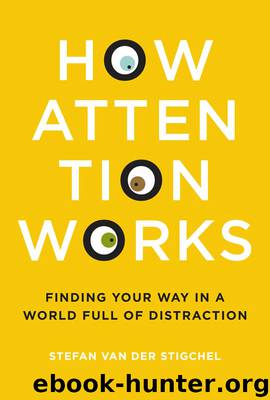How Attention Works: Finding Your Way in a World Full of Distraction by Stefan van Der Stigchel

Author:Stefan van Der Stigchel
Language: eng
Format: epub
Publisher: MIT Press
Published: 2019-02-15T00:00:00+00:00
We usually know exactly where important objects are located after each eye movement. We update the visual representations of an object after each movement so that a fork, for example, is still the same object after each subsequent eye movement. To facilitate this, the visual system needs to know the magnitude of each eye movement. Whenever a movement of a certain magnitude is made, an update of the same magnitude must be carried out as well. Various studies of monkeys’ brains have shown that an update of the same magnitude takes place just before an eye movement. The brain seems to possess a kind of map that helps to ensure that we know exactly where important objects are located in relation to ourselves, regardless of where we happen to be looking.
Of course, we do not update the representation of every object around us after each eye movement. It would cost far too much time and energy to carry out such complicated calculations. We do this only for the most important objects—a maximum of three or four. This is primarily because we use the visual world as a kind of external hard drive. Given that we can only represent a few objects in our internal world at any given moment, it is only these objects that we take into consideration when we move our eyes. For example, it is impossible for us to know the exact location of each knife on a table set for eight people after each eye movement that we make.
A similar updating process occurs in the case of memory signals. In order to know where you have already searched when you are looking for something, you need to remember those locations. If you don't do this, you will only end up searching the same places over and over again. We have already seen that we suppress attention to prevent us from searching the same place twice. With each eye movement, the locations that have already been searched are projected onto a different part of the retina. So if you want to remember where you have already searched, you have to update these parts, too. This process has its limits, however, as you are only capable of recalling a handful of places you have previously searched. One solution is to add some structure to your search. If you know that you always search your bookcase, for example, from top left to bottom right, then all you need to do is to remember this strategy. This is why searching in a haphazard manner is so inefficient: you are never able to recall all of the individual locations that you have already searched.
Another limit of the eye-movement system is the number of movements that can be carried out at any given time: only one. This means that the decision-making process that determines the direction of each eye movement is constant and continuous. The process is very similar to the competition between the internal and external worlds in the battle for our attention.
Download
This site does not store any files on its server. We only index and link to content provided by other sites. Please contact the content providers to delete copyright contents if any and email us, we'll remove relevant links or contents immediately.
The Art of Thinking Clearly by Rolf Dobelli(10324)
Mindhunter: Inside the FBI's Elite Serial Crime Unit by John E. Douglas & Mark Olshaker(9263)
Change Your Questions, Change Your Life by Marilee Adams(7684)
Nudge - Improving Decisions about Health, Wealth, and Happiness by Thaler Sunstein(7658)
Mastermind: How to Think Like Sherlock Holmes by Maria Konnikova(7278)
The Power of Now: A Guide to Spiritual Enlightenment by Eckhart Tolle(5680)
Men In Love by Nancy Friday(5192)
Altered Sensations by David Pantalony(5071)
Factfulness: Ten Reasons We're Wrong About the World – and Why Things Are Better Than You Think by Hans Rosling(4713)
The Confidence Code by Katty Kay(4220)
Thinking in Bets by Annie Duke(4185)
Man and His Symbols by Carl Gustav Jung(4095)
The Worm at the Core by Sheldon Solomon(3450)
Why Buddhism is True by Robert Wright(3423)
Liar's Poker by Michael Lewis(3413)
Three Women by Lisa Taddeo(3393)
The Inner Life of Animals by Peter Wohlleben(3285)
Descartes' Error by Antonio Damasio(3248)
How Music Works by David Byrne(3234)
